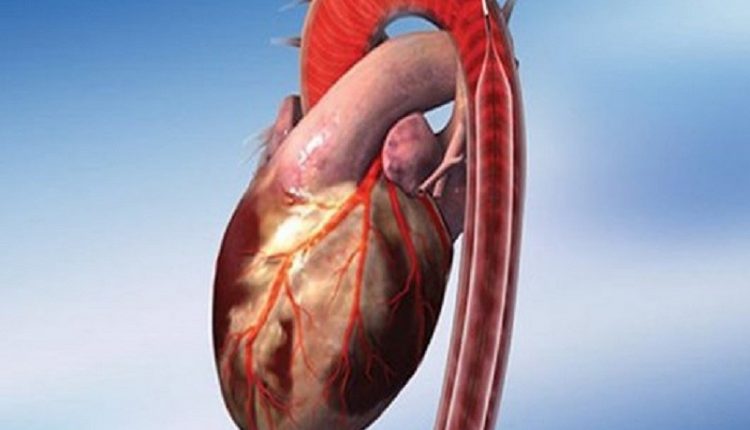
ភាពមិនប្រក្រតីនៃការបញ្ជូនចរន្តអគ្គិសនី៖ រោគសញ្ញា Wolff Parkinson White Syndrome
រោគសញ្ញា Wolff Parkinson White គឺជារោគសាស្ត្រនៃបេះដូងដោយសារតែការបញ្ជូនមិនប្រក្រតីនៃចរន្តអគ្គិសនីរវាង atria និង ventricles ដែលអាចបណ្តាលឱ្យ tachyarrhythmias និងញ័រទ្រូង។
Wolff-Parkinson-White syndrome manifests itself with tachyarrhythmias in which the patient experiences excessive heart palpitation, in some cases associated with fainting, dizziness, chest pain, difficulty breathing.
In this syndrome, there will be the presence of an accessory bundle, Kent’s bundle, which connects the atrium and ventricle; in this way when the electrical impulse from the sinus node is dispersed in the atrial wall before reaching the atrioventricular node, Kent’s bundle will pick up electrical signals making the ventricle contract a few milliseconds earlier than normal, creating ventricular pre-excitation.
The tachycardia in Wolff-Parkinson-White syndrome may be atrioventricular reentrant, when it is characterized by an abnormally fast heart rhythm and the tachycardia is classified as supraventicular.
Atrial fibrillation is a pathology characterized by the fast and disorganized contraction of the atria, triggered by electrical impulses from myocardial muscle cells which, under normal conditions, thanks to the presence of the atrioventricular node, are “filtered” and sent in smaller quantities towards the ventricles causing these not to contract as fast as the atria.
The presence of the bundle of Kent instead allows the atrial impulses to be picked up without a filter by sending electrical signals of contraction to the ventricles, increasing the frequency originating a tachyarrhythmia that could be lethal.
The most affected are healthy young people, who therefore have a heart that is not necessarily sick, who complain of episodes of occasional tachycardia, while in others they do not warn of any discomfort.
Wolff Parkinson White syndrome diagnosis
Wolff Parkinson White is diagnosed with an electrocardiogram.
Those affected by this pathology can experience sudden cardiac death, due to the high-speed propagation of the atrial arrhythmia towards the ventricles.
How is Wolff-Parkinson-White syndrome treated?
Wolff Parkinson White patients who have tachyarrhythmias should be treated with:
- Vagal manoeuvres, in order to reduce the heart rate, if the patient is correctly instructed can perform this maneuver autonomously.
- Administration of drugs that block conduction through the atrioventricular node by interrupting one of the arrhythmia arms. Drugs that should be avoided in case of atrial fibrillation because in some cases they could increase the frequency of conduction to the ventricles through the accessory pathway resulting in ventricular fibrillation.
- Electrical cardioversion, a procedure in which the electrical conduction of the heart is “reset” by the defibrillator, in order to restore a normal heart rate.
Ablation is considered the definitive solution in case of frequent recurrences.
It is a minimally invasive procedure that allows you to cancel the anomalous electrical paths, in this case they are Kent’s bundles.
It sees the partial destruction of the accessory pathway, by catheter ablation, i.e. delivery of energy at a specific frequency through a catheter inserted into the heart; it is successful in over 95% of cases.
Ablation is particularly useful in young patients who may otherwise be forced to take antiarrhythmic drugs for life.
សូមអានផងដែរ
Emergency Live រឹតតែខ្លាំង… Live៖ ទាញយកកម្មវិធីឥតគិតថ្លៃថ្មីនៃកាសែតរបស់អ្នកសម្រាប់ IOS និង Android
តើអ្វីជាហានិភ័យនៃរោគសញ្ញា WPW (Wolff-Parkinson-White)
Wolff-Parkinson-White Syndrome: តើវាជាអ្វី និងរបៀបព្យាបាលវា។
Wolff-Parkinson-White Syndrome: រោគសរីរវិទ្យា ការធ្វើរោគវិនិច្ឆ័យ និងការព្យាបាលនៃជំងឺបេះដូងនេះ
Semeiotics នៃបេះដូងនិងសម្លេងបេះដូង: សម្លេងបេះដូង 4 និងសម្លេងបន្ថែម
រអ៊ូរទាំបេះដូង៖ តើវាជាអ្វី ហើយមានរោគសញ្ញាអ្វី?
ប្លុកសាខា៖ មូលហេតុ និងផលវិបាកដែលត្រូវយកមកពិចារណា
ការសង្គ្រោះបេះដូងពីសួត៖ ការគ្រប់គ្រងម៉ាស៊ីនបង្ហាប់ទ្រូង LUCAS
Supraventricular Tachycardia: និយមន័យ ការធ្វើរោគវិនិច្ឆ័យ ការព្យាបាល និងការព្យាករណ៍
ការកំណត់អត្តសញ្ញាណ tachycardia: តើវាជាអ្វី មូលហេតុ និងវិធីធ្វើអន្តរាគមន៍លើ tachycardia
ជំងឺ Myocardial Infarction: មូលហេតុ, រោគសញ្ញា, ការធ្វើរោគវិនិច្ឆ័យនិងការព្យាបាល
ភាពមិនគ្រប់គ្រាន់ Aortic: មូលហេតុ រោគសញ្ញា ការធ្វើរោគវិនិច្ឆ័យ និងការព្យាបាលនៃ Aortic Regurgitation
ជំងឺបេះដូងពីកំណើត៖ តើអ្វីជា Aortic Bicuspidia?
ជំងឺបេះដូង atrial Fibrillation: និយមន័យ មូលហេតុ រោគសញ្ញា ការធ្វើរោគវិនិច្ឆ័យ និងការព្យាបាល
Ventricular Fibrillation គឺជាជំងឺស្ទះសរសៃឈាមបេះដូងធ្ងន់ធ្ងរបំផុតមួយ៖ ចូរស្វែងយល់អំពីវា
Atrial Flutter: និយមន័យ មូលហេតុ រោគសញ្ញា ការធ្វើរោគវិនិច្ឆ័យ និងការព្យាបាល
តើ Echocolordoppler នៃ Supra-Aortic Trunks (Carotids) គឺជាអ្វី?
តើ Loop Recorder គឺជាអ្វី? ការរកឃើញ Telemetry នៅផ្ទះ
Cardiac Holter, លក្ខណៈនៃ Electrocardiogram 24 ម៉ោង។
ជំងឺសរសៃឈាមខាង ៗ : រោគសញ្ញានិងការធ្វើរោគវិនិច្ឆ័យ
ការសិក្សា Electrophysiological Endocavitary: តើការប្រឡងនេះមានអ្វីខ្លះ?
ការពិនិត្យបេះដូង តើការពិនិត្យនេះជាអ្វី?
Echo Doppler: តើវាជាអ្វី និងសម្រាប់អ្វី?
Transesophageal Echocardiogram: តើវារួមបញ្ចូលអ្វីខ្លះ?
អេកូបេះដូងកុមារ៖ និយមន័យ និងការប្រើប្រាស់
ជំងឺបេះដូង និងសំឡេងរោទិ៍៖ Angina Pectoris
ក្លែងក្លាយដែលនៅជិតបេះដូងរបស់យើង៖ ជំងឺបេះដូង និងរឿងមិនពិត
ការគេងមិនដកដង្ហើម និងជំងឺសរសៃឈាមបេះដូង៖ ទំនាក់ទំនងរវាងការគេង និងបេះដូង
ជំងឺ Myocardiopathy: តើវាជាអ្វីនិងរបៀបព្យាបាលវា?
ជំងឺស្ទះសរសៃឈាមវ៉ែន៖ ពីរោគសញ្ញាទៅជាថ្នាំថ្មី។
ជំងឺបេះដូងពីកំណើត Cyanogenic: ការផ្លាស់ប្តូរនៃសរសៃឈាមធំ
ចង្វាក់បេះដូង៖ តើ Bradycardia ជាអ្វី?
ផលវិបាកនៃការប៉ះទង្គិចទ្រូង៖ ផ្តោតលើការប៉ះទង្គិចបេះដូង
អនុវត្តការប្រឡងគោលបំណងនៃសរសៃឈាមបេះដូង៖ ការណែនាំ



